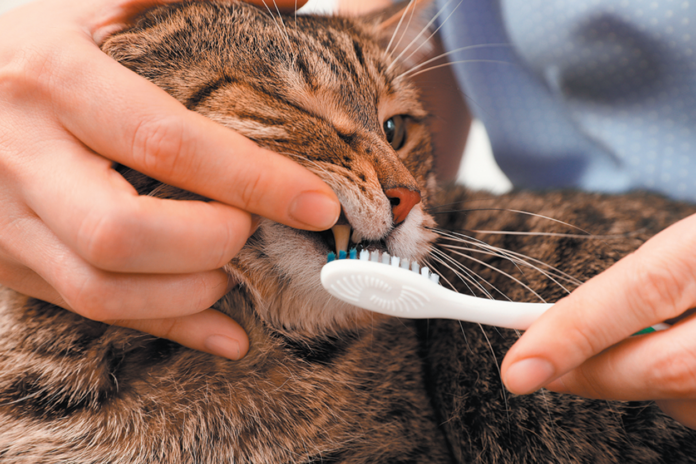There’s never an age at which you can stop caring for your cat’s teeth. If anything, dental health becomes even more important for an older cat. Neglected teeth and gums can result in severe mouth pain and sometimes lead to infections in various body organs, says the American Association of Feline Practitioners. Additionally, a cat with untreated oral disease and dental pain might become malnourished and too thin, which can lead to a cascade of issues that include compromised immunity to disease. In a cat’s later years, such problems resulting from a lack of dental care only become harder to overcome.
Regularly brushing your cat’s teeth is one way to help ward off dental disease. Brushing at least every other day is necessary for removing soft, sticky plaque. If you wait three days, the plaque hardens below the gum line, and no amount of brushing will remove it. It will sit there compromising the gums until your cat’s teeth are scaled under anesthesia by a veterinarian.
But even if you haven’t regularly been brushing your cat’s teeth throughout her life, there are things you can do right now to ward off dental pain and the compromised health that accompanies it.
- Take your cat for regular dental check-ups and cleanings at the doctor’s office, whether or not you brush her teeth. Your veterinarian will recommend an appropriate schedule. It might be once a year or twice a year.
- Inspect your cat’s mouth regularly for tartar (hardened plaque) or changes in the appearance of the gums.
- Pay attention to your cat’s eating habits. Has your older pet been eating less food or showing less interest in food? Chewing on one side? Dropping food out of her mouth while she eats or eating more slowly? Take her in. These are all signs of dental pain that need to be addressed professionally.
- Note the following signs: red, swollen, or bleeding gums; bad breath; sores in your cat’s mouth. None of these are going to just “go away,” and all of them indicate a problem that can cut into your pet’s emotional wellbeing as well as her physical health. Get your cat to the veterinarian.
Some 15-year-old cats might be too crotchety to let you start bushing their teeth after a lifetime of not having anybody poke around their mouths. But if you have a mellow older cat whose teeth you have never brushed, you might be able to adjust her to the habit.
Go slowly. It could take months. But you’ve waited this long. What’s a little more time? (This really is a case of “Better late than never.”)
- Start by placing your cat on a countertop every day at the same time, advises board-certified veterinary dentist Bonnie Shope, VMD, a member of Catnip’s editorial advisory board. And don’t ram a toothbrush into her mouth. Instead, just rub and pet her face for 30 to 60 seconds, all the while offering praise. Follow up immediately with a treat or other reward.
- After the days or weeks it takes your cat to become acclimated to the routine, hold a toothbrush in one hand each day while continuing to pet and stroke her. Don’t forget the ongoing praise and the reward at the end. If things are going well, you can even introduce cat toothpaste with the treat. Put a small amount on the treat — or her paw — so she can lick it off. Try salmon-flavored or another fish flavor — and keep praising!
- Once your cat seems ready, gently hold her head. Brush one side and then, tilting her head a bit, the other. Finish up by brushing the teeth in the front. Voila! The whole process takes about a minute.
Don’t feel bad if your cat never gets the hang of it. Some cats don’t, and your bond with her is more important than a daily or near daily tussle that leaves both of you miserable. If you take your pet to the vet for regular dental check-ups and cleanings, you’re still doing a lot to protect her teeth and her overall health.





This was